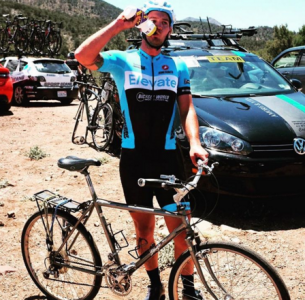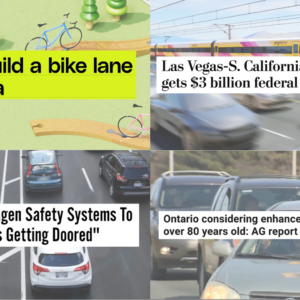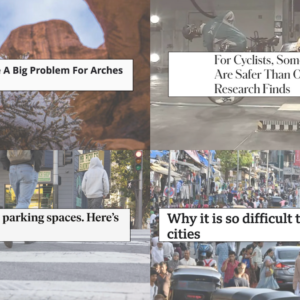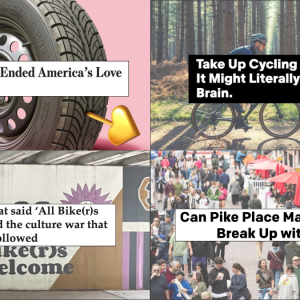
(Photo via Allison)
This week’s Monday Roundup is sponsored by 21st Avenue Bicycles, your summer bike adventure suppliers.
Here are the bike-related links from around the world that caught our eyes this week:
Bike swap: A racer on New Mexico’s grueling Tour of the Gila broke his bike in a Stage 1 crash — but swapped with a spectator and “rode a bitchin’ early-80’s Specialized to the finish,” complete with rear rack.
Detroit Bikes: Motivate, the country’s largest bike share operator is shifting assembly to Detroit.
Solar e-bike: It recharges its own batteries.
Waterslide commuting: A Democratic candidate for governor has a plan to solve congestion between Portland and Vancouver: two massive water slides, each descending to the other side of the river from the top of a 30-story parking garage.
Transit parking: “Bike parking is possibly the most cost-effective way to support transit ridership,” concludes a new literature review of transit parking policy.
Truck-only lanes: Freight will get two dedicated lanes on 38 miles of I-75 near Atlanta.
People who speed: They seem to share common psychological characteristics with people who drive drunk.
London mayor: The newly elected Sadiq Khan “talks a decent talk on cycling, but some fear his heart is not in it.”
Advertisement
Road negotiation: Oregon Gov. Kate Brown has convened a big stakeholder committee (including the Bicycle Transportation Alliance) to work on a transportation deal.
Against “accident”: “Ask any first responder or cop the number one problem in a winter ‘accident’ and they’ll tell you speed,” writes Lorraine Sommerfeld of the auto website Driving, making the case for the word “collision.”
Freeway movie: The Colorado Department of Transportation shot and produced a 30-minute film about how great a freeway expansion will be for the immigrant community it’s supposed to run through. It got 135 views in six months.
Why suburbia? Most Americans choose suburbs not because they love suburbs but because they’ve decided to prioritize what suburbs offer — despite “social and environmental costs that many people simply don’t want to pay.”
Jane Jacobs: The late writer, born 100 years ago last week, was to urban planning as “Freud was to psychology,” but “nearly everywhere” that has followed her advice, “gentrification and displacement follow.”
Woody Allen: The filmmaker showed up at a community board meeting in New York City to oppose a bike lane on E. 70th Street.
Seattle commuting: The temporary closure of the Alaska Way Viaduct is leading to a massive boom in bike use.
Seattle joyride: Last Thursday night, 75 cyclists snuck onto the closed Viaduct for a night ride above the city.
Seattle backpedal: Months after voters overwhelmingly approved a pro-bike transportation levy, Seattle has halted most progress on its central-city bike plan.
Biking and pollution: The health benefits of physical activity easily outweigh the harms from breathing more dirty air while walking or biking.
Homelessness and danger: People who live in tents face far more risk themselves than anyone biking past them does, says Portland writer Elly Blue.
If you come across a noteworthy story, send it in via email, Tweet @bikeportland, or whatever else and we’ll consider adding it to next Monday’s roundup.
— Michael Andersen, (503) 333-7824 – michael@bikeportland.org
Our work is supported by subscribers. Please become one today.






Thanks for reading.
BikePortland has served this community with independent community journalism since 2005. We rely on subscriptions from readers like you to survive. Your financial support is vital in keeping this valuable resource alive and well.
Please subscribe today to strengthen and expand our work.
Woody Allen opposition to a bike lane: a brilliant takedown.
Moskowitz’ take down of Jane Jacobs strikes me as pretty weak. Can we really blame her for rapid population growth and the massive rise in inequality? Those strike me as the two chief forces behind the gentrification he laments, not Jacobs’ commitment to place and diversity of uses.
Woody Allen could head a new organization “Pedophiles against Bikelanes.”
The take down of Jane Jacobs is backward. The problem is not that places built with her design criteria in mind equal gentrification. It is that we have made most places in America Souless Suburban Wastelands. That combined with our market based land ownership system ( yes there are other kinds) assures that if we build very few good places the people with the most money will take them over. The solution is to build ( or rebuild) everywhere to meet the needs of actual humans as opposed to cars and strip mall commerce. Then there won’t be only a few good places that the rich will outbid the rest of us for.
Right, that’s a huge part of it. A functional public realm is sold as an amenity because so many places lack it; an attractive public realm becomes a luxury good. It’s not so different in Europe, though often with lower rates of car ownership throughout.
Jacobs’ famous works had a free-market bent to them and were skeptical of planning. When the mass of American capital was abandoning central cities that were already planned and platted, there was plenty of room for free-market principles to work on the substrate of that planning, the act of which was conveniently forgotten in the past. Now that the mass of American capital is moving back toward these places we find we have a shortage of them — and the free market doesn’t just build more without excellent planning! And what the free market does build is exclusive (just as many of the subdivisions built in the latter half of the 20th century were)!
The most important work for the next generation of planners is going to be augmenting the public realms of the last few generations of urban sprawl.
Compared to city dwelling, suburbs have peace and quiet, and a little private open space…the front and back yards…that city dwelling rarely is able to offer. These things are some of the reasons people seek to live in suburbs, despite some of the lesser appealing things about suburbs.
Some of Portland’s close in neighborhoods, such as NW, NE, SE and parts of SW were suburbs at one time. Some still are, though less so where commercial and retail centers relatively small compared to Downtown, developed on certain of the thoroughfares through the neighborhoods.
Having seen the green, wooded and fields, hillsides of the countryside be transformed into vast seas of grey asphalt roofs, I’m not a big fan of suburbs, or of so called ‘infill’ for that matter (methodically demolishing green open space within neighborhoods and on scenic recreational routes such as Fairmount Blvd, around Council Crest.). The cause of that transformation though, I think is due to people fleeing the commotion of city dwelling. Doesn’t matter how materialistically dazzling a place like the Pearl is, such neighborhoods still lack the relative quietude of suburban dwelling.
Unfortunately, I think poor people tend to get left with the worst of what’s left over after these ‘wonderful transformations’ are made. They get to live Downtown, but in the worst of conditions. Can’t afford to live out in the burbs, unless it’s in the woods.
Squirm if you like for a compassionate take, but we’re all pinned to the same fact: surrendering the commons to squalor and anarchy isn’t decent or fair to anyone.
As a thought experiment: sell prime parkland to developers, use the money to help the unhoused, and there’d be zero net loss of public space. Instinctively it isn’t an appetizing idea, but then I remembered the status quo.
Maybe worth considering–along with strict, no-exemptions regulation of the cost of housing. We have to question our notions of private property rights extending to the right to sell or rent to the highest bidder. Read what is happening in New York, Vancouver BC, and Miami with property being used as a stashing place for foreign dirty money.
Perhaps, if we could elide the connection between “foreign” and “dirty”. A hell of a lot of the money doing this around the world (Switzerland, Cayman, Panama) is all-American, and anyway, it’s an American game being played, by American rules.
“stashing place for foreign dirty money.”
It’s not just “dirty” money; I can introduce you to Chinese and Israeli investors who bought property in the US (with legitimate funds) to hedge against currency drop. From what I understand, this was a very popular reason for the housing run-ups over the past several years.
As a suburb dweller I claimed to hate what suburbs represent and justified where we bought our house based on proximity to work, family, and affordability. Looking back though I very much liked having a decent sized yard, garage, quite neighborhood etc… Fast forward 2 years and I am finally getting to the point that those personal “spaces” are not worth not being able to walk or even easily bike to a restaurant, everyone being secluded away in their homes all the time and the general consumer mindset it creates.
It’s obvious the main factor in the suburbs viability is the personal car. I think the solution has to involve a dramatic shift regarding public vs private space but just exchanging some roads for cycling / walking space and having smaller commercial areas mixed into developments (why can’t a corner lot in a neighborhood be a cafe?) and less huge shopping centers. The nearest coffee shop to me is either a drive thru or starbucks both over a mile away… The closest grocery stores are either a walmart or safeway both over a mile away, rode to safeway mothers day morning for half and half with my kid in the bike trailer… what a horrible experience. It wasn’t until committing to ride by bike whenever possible that I began to realize how horrible the suburbs are for anyone not driving a car. How do we get other people to realize this? Make driving more expensive and biking easier, I don’t care how at this point.
Edit: “DOESN’T have to involve a dramatic shift in public vs private space”
We’re up to ~50% walking/biking to school at our elementary school for May, which is great. But why are we not at 100%? The weather has been beautiful, everyone lives within 1 mile, and the routes are safe. Why do people feel they need to drop their kids off 20 feet from the front door of the school? We’ve done lots of encouraging for the kids who are walking and biking, but we seem to have leveled off — I really wonder if the only thing we can do at this point is to make it absolutely horrible (or impossible) for parents to drive to school.
I attribute this to a uniquely-American obsession with convenience and comfort.
Nope,it’s over-protective parenting and a lack of bus service for PPS kids.
I was pretty much shoo’ed out the door of my house every morning. It was my choice how to get to school but because I had a paper route, I usually biked it. The reason I was left to my own to get to school was because it interfered with my parents convinced to get me there.
If it was about convenience every kid would basically be pushed out the front door every morning – as the standard was some odd 30+ years ago.
That’s what we do. It’s very convenient to open the garage door, get the kids on their bikes and see them off.
Local stores or restaurants on a corner in a suburban neighborhoods sounds like a nice idea, but they would lack the volume of customers needed to make the business viable unless people were coming from further away as well.
Ultimately I think there is a conundrum of lifestyle choice that must be made in more populated areas. The suburban model is highly inefficient, but the personal space and solitude offers a haven from (often) hectic city life. A good compromise might be to realize a mostly urban living model and find a way to offer people the peace and quiet their souls need, away from the city, from time to time.
These sorts of discussions, along with those related to equity, are difficult to have in this society without being dismissed as communist or anti-American. That is, for those who can focus enough attention away from the social media outlets.
My neighborhood is 30k people who have to to get to the edge of the neighborhood for all the chains and shopping centers along Allen blvd and drive to washington square, progress ridge or downtown beaverton for anything decent…
If Portland Heights / Southwest Hills can support Vista Springs Cafe being that close to everything downtown I think even just a coffee shop could manage if it was the only spot within half a mile for roughly 20k people…
I agree with you though, so little time is spent outside of either the house or a car in the suburbs it’s ironic people want to live there for the “space”. I’d give up some of the space I use so little if it meant the areas I do spend most my time outside of work and the house (commuting, eating out, seeing family and friends, excercise) more enjoyable.
I lived at Allen/Murray across from the Safeway. When I lived there I walked to/from the grocery store because it was so close, but I rode all over that area and found Allen a little sketchy in spots but quite easy biking access to corporations, stores, bars, MAX stations, etc. Meanwhile I had neighbors and even a roommate who would jump in their cars almost nightly to drive less than a mile to the Safeway, only to return with a small (usually plastic) bag or two for dinner. More than once I won bets with my roommate that I could reach the front door (without running) before he could cross on a green light and find parking. I would argue that those people didn’t need to drive, and it wasn’t that the suburbs are so spread out that encouraged them to.
I suppose if they were in the city, they’d have had to fight so hard to find a parking place that they’d be incentivized to walk instead of risk losing it. We still see American city dwellers as mostly car owners, despite them having corner stores in walking distance (which the suburbs often do too).
It’s funny that people consider SE Portland “hectic city life”. Back in the 1920’s, most of the east side was a suburb, although the kind of suburb that was not built around universal car ownership like today’s are. Hence the walkability and corner markets.
Ultimately, Americans seem to value private space over public ones. Me personally, I’d much rather have a larger space that I share with everyone than a small space just for myself.
“Ultimately, Americans seem to value private space over public ones.”
Americans?
That presumes that land use patterns follow from individual choice and preference; that there are mechanisms by which those determine and shape what is built and where. I see very little evidence of this. Maybe if you substitute capitalism in that sentence it would read better.
“It’s obvious the main factor in the suburbs viability is the personal car.”
I’m curious to know why you say this, and what differences you feel cities offer over suburbs – related specifically to bicycle travel. In many of the suburbs I’ve lived in there have been ample bike lanes and relatively easy bicycle travel – more than in the cities I’ve lived in. As a result I’ve typically avoided bicycling in cities because there are typically more cars and more stops/intersections.
Our country’s growth was accompanied by a myopic focus on the automobile; some would argue it played a key role in that growth. I think you’ll find that’s the reason that suburbs are car-centric: we live in a car-centric country! But your post seems to imply that cities are somehow less car-centric (due to less centralized shopping? fewer big box stores?), at least at my read. But if you go to US cities that have poor public transportation, you will find them equally if not more car-centric than other (more progressive?) cities with light rail, good bus lines, trains from outer burbs, etc.
Would you consider Santa Clara, CA a suburb? I certainly would, yet we have ample bike lanes and routes, on-street connecting with Class I trails, and bike commuting and recreational cycling is quite widespread here. The strip malls pose right-hook dangers and there are definitely roads you wouldn’t want to cycle on, but I’d take riding here over downtown Houston, Erie, Chicago, many parts of Boston, even parts of NW Portland (near 405).
My point is that I find bicycling in the suburbs quite viable, and though I have a personal car I rarely use it for local travel and don’t find it a requirement for suburban living (regardless of how many of my neighbors do).
Freeway movie working link: http://denver.streetsblog.org/2016/05/02/hickenloopers-dot-casts-itself-as-the-hero-in-i-70-propaganda-film/
Here’s a link to a Gothamist article about the NYC upper east side proposed bike lanes, that it seems to me is far more informative about the situation than the article introduced in today’s Roundup:
http://gothamist.com/2016/05/05/woody_allen_bike_lane.php
This issue of bike lanes proposed in upper east side NYC, has been going on for quite some time, and apparently, there is far more opposition to it than from Woody Allen. Not having been there, I don’t know that bike lanes would be the terrible thing that some of the residents of that area seem to think.
The short, NY Daily News story though, does a nice, kind of funny job of referring to some of the stunts Woody Allen has pulled, that I think in the minds of many people with a common sense of decency, has reduced him to the status of ‘not so nice person’.
Of all the women there are in the world, that he likely could have got together with, he’s got to hook up with his ex-wife’s adopted daughter? Maybe he exercising just a tiny, tiny bit of self restraint would have been the better thing to have done.
And maybe he ought to consider getting some exercise on a bike on the streets of NYC too, at least with an e-assist bike. But on the other hand, maybe everyone in need of using the streets of NYC to get around, will be a lot safer if the neurotic nut some people say Woody Allen is, continues to stay off bikes, and maybe off the street entirely, unless being driven in a taxi…as if that mode of travel isn’t bad enough for vulnerable road users to share the streets with.
I agree. There wouldn’t be such a high demand for the few nice places if more places were nice.
Re. bike parking near transit, the Dutch national railway company, Nederlandse Spoorwegen, and the German national rail company, Deutsche Bahn, both have their own bike rental systems which are primarily meant to bring in train customers.
If people can bike to the train station, lock their’s up in a secure place, take a train to another city knowing that they can rent a bike on the other end, they’ll decide to take the train.
(Of course Europe has amazing passenger rail between cities.)
Re: finishing Gila stage on an old mountain bike —
Well, old vintage Stumpys are REALLY gonna cost a fortune on eBay after this.
I know that induced demand is now proven to hold true in terms of adding travel lanes increases congestion. It looks like Seattle’s experience with what appears to be an increase in bike use/purchases may show that the other aspect of induced demand also holds true. Namely, if we reduce travel lanes we may also reduce driving and perhaps also congestion.
I’m sure there are sources of proper data out there. I hope someone much smarter than me plunges into them and shows this is the case so we can begin to adjust policy in a sensible direction.
Traffic evaporation.
The BBC is hopeless when it comes to its science reporting but I believe BikePortland can do a better job.
This is how the actual study summarizes their findings: